
Rok Blagus and Luka Lindic break trail after a week of bad weather in the Bhagirathi group of India’s Garhwal Himalaya. The pair, along with Marko Prezelj, climbed three new routes there last month after a permit mix-up brought them to the area. [Photo] Marko Prezelj
A permit mix-up changed the climbing venue for three Slovenian alpinists last month. The result: three significant new routes in the Bhagirathi group of India’s Garhwal Himalaya (read more in the October 18, 2009 NewsWire).
For six months, Marko Prezelj, Rok Blagus and Luka Lindic were planning an expedition to Rimo I (7385m) in the Indian Karakoram. They received notice that the Indian Army would not allow their proposed climb just three weeks before departure. The team immediately switched their objective to the Bhagirathis.
“I didn’t work much on collecting information for the replacement destination,” Prezelj said. “I knew that Bhagirathis are interesting for steep climbing and that was enough. I discovered during the trip approach, descent, routes, history and other information I normally check before the departure… In general it was a kind of ‘on sight’ trip.”
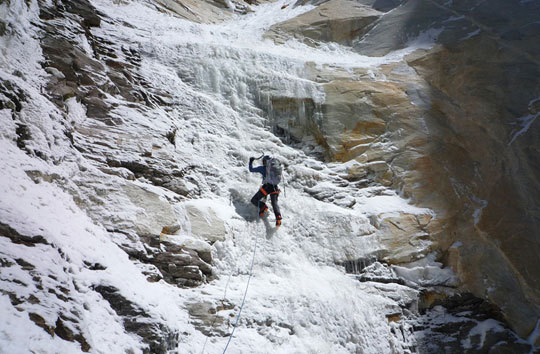
Prezelj leads an ice pitch on Bhagirathi IV. [Photo] Rok Blagus
Adding insult to injury, Blagus said, when the team arrived in Delhi they discovered that their liaison agency had misinterpreted the army’s suggestion. Plans already in motion for the Bhagirathis, they began the four-day trek to base camp at Nandanvan (ca. 4350m). They arrived on September 4, set up camp and waited out a week of lightning, rain and snow. When the weather cleared, they found even the steepest faces covered by snow. The team kept high spirits and set their sights on south- and west-facing slopes.
“We were there to climb,” Blagus said. “And it actually did not make much difference if we climbed hard rock or just some snow slopes.”
Following this philosophy, the trio took an obvious but previously unclimbed route (D+, 1000m) up Bhagirathi IV (6200m) on September 15 to acclimatize.
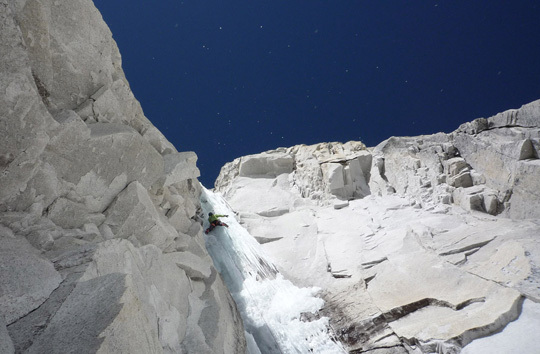
Prezelj leads an ice pitch on Bhagirathi II. [Photo] Luka Lindic
A week later, without scoping their line (ED [6b (5.10d) M5 WI5], 1300m) prior, they climbed Bhagirathi III (6454m). Arriving at the waterice section at midday, the team had to navigate wet rock and unstable, difficult-to-protect ice.
The gem of the trip was an ascent of Bhagirathi II (6512m) via “the most obvious line” in the region, Blagus said. The ascent, climbed from September 29 to October 1, was climbed at an impressive ED+/ABO (6b+ [5.11a] M8 WI6+, 1300m).

Blagus and Lindic descend from the narrow summit of Bhagirathi IV. Bhagirathi III is in the background. [Photo] Marko Prezelj
The ascents of Bhagirathi III and Bhagirathi II were not climbed entirely free; the team made two rappels on route and descended via a 5-meter pendulum, respectively. However, all three ascents were climbed without fixed ropes or other support, and all pitches were climbed by the leader and seconds without other aid or ascenders. On Bhagirathi II, the partners led in blocks of four pitches each.
The team climbed light, bringing two sleeping bags and no tents.
They left base camp on October 4 and returned to Slovenia four days later.
Blagus and Prezelj said the routes had excellent snow, ice and rock, which resulted in phenomenal climbing. And the trip was a success, Blagus said, because they “took things step by step and adjusted plans and strategies according to conditions, which was possible only because we were not preoccupied with goals and numbers.”
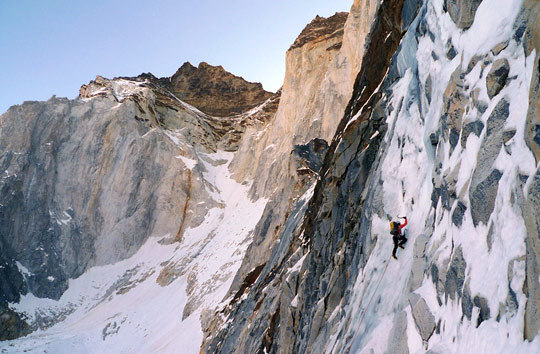
Lindic starts up a new route on Bhagirathi III. [Photo] Marko Prezelj
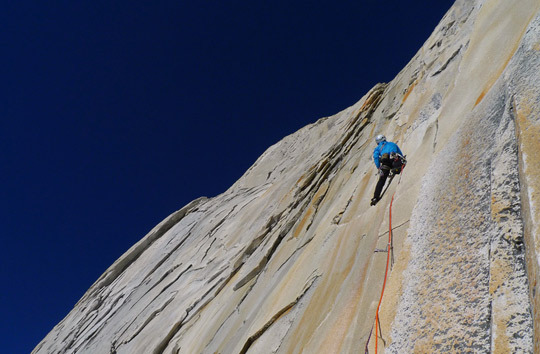
Blagus climbs a section of rock on Bhagirathi III. The team encountered significantly wet conditions during the climb. [Photo] Marko Prezelj
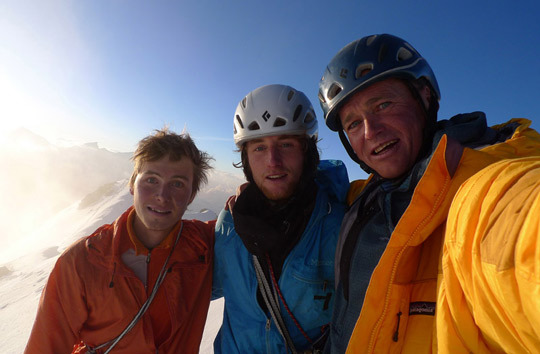
Left to right, Lindic, Blagus and Prezelj on the summit of Bhagirathi III. Prior to this expedition Blagus, 27, climbed one-on-one regularly with Lindic, 21, and Prezelj, 44. However, before September all three had teamed up together only once, two years ago in Slovenia’s Julian Alps. [Photo] Marko Prezelj